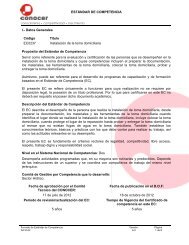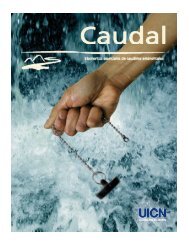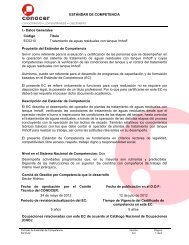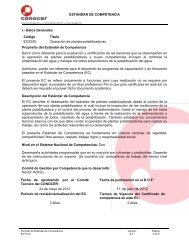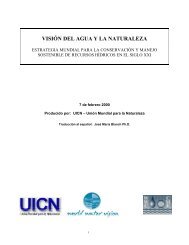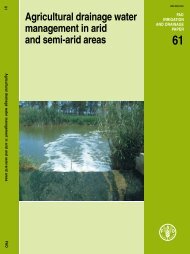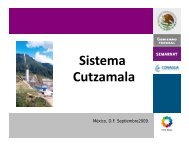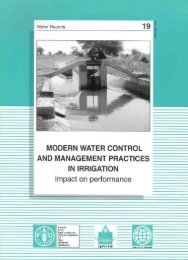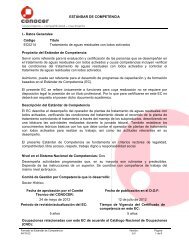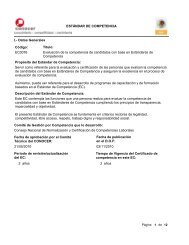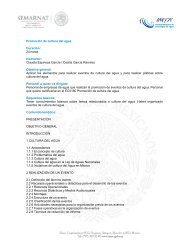An Assessment of the Status of Biodiversity in the Muthurajawela ...
An Assessment of the Status of Biodiversity in the Muthurajawela ...
An Assessment of the Status of Biodiversity in the Muthurajawela ...
Create successful ePaper yourself
Turn your PDF publications into a flip-book with our unique Google optimized e-Paper software.
5. Water Quality<br />
Water quality measurements<br />
The average measurements <strong>of</strong> eight water quality parameters that were obta<strong>in</strong>ed from different<br />
areas/aquatic habitats <strong>of</strong> <strong>the</strong> <strong>Muthurajawela</strong> wetland sanctuary dur<strong>in</strong>g <strong>the</strong> high ra<strong>in</strong>fall (higher<br />
water flow) and low ra<strong>in</strong>fall (lower water flow) periods are presented <strong>in</strong> Table 7. The average<br />
pH values <strong>of</strong> all sampl<strong>in</strong>g areas falls with<strong>in</strong> <strong>the</strong> standard pH range (6 - 8.5) for fish and aquatic<br />
life. Interest<strong>in</strong>gly, <strong>the</strong> average dissolved oxygen (DO) levels <strong>in</strong> all sampl<strong>in</strong>g areas were below<br />
<strong>the</strong> mean standard DO (6 mg/l) for fish and aquatic life. However, <strong>the</strong> average DO levels <strong>in</strong> <strong>the</strong><br />
majority <strong>of</strong> <strong>the</strong> areas were above <strong>the</strong> standard daily m<strong>in</strong>imum level (3 mg/l) for fish and aquatic<br />
life. In general, <strong>the</strong> lower levels <strong>of</strong> DO <strong>in</strong> <strong>the</strong> <strong>Muthurajawela</strong> wetland sanctuary could be<br />
attributed to <strong>the</strong> decomposition <strong>of</strong> peat matter, which results <strong>in</strong> de-oxygenation. The DO levels<br />
<strong>in</strong> <strong>the</strong> canal and marsh habitats <strong>of</strong> <strong>the</strong> Wahatiyagama (West) area were very low, possibly due<br />
to <strong>the</strong> proliferation <strong>of</strong> <strong>the</strong> alien <strong>in</strong>vasive float<strong>in</strong>g plant Salv<strong>in</strong>ia molesta (<strong>in</strong> <strong>the</strong> canal) and <strong>the</strong><br />
higher decomposition <strong>of</strong> peat (<strong>in</strong> <strong>the</strong> marsh) respectively.<br />
In general, <strong>the</strong> average BOD5 and COD levels <strong>in</strong> <strong>the</strong> different sampl<strong>in</strong>g locations were much<br />
higher than <strong>the</strong> average standard levels <strong>of</strong> BOD5 (4 mg/l) and COD (15 mg/l). Although this<br />
situation could be normal for a peat bog ecosystem, it is alarm<strong>in</strong>g to note that <strong>the</strong> level <strong>of</strong> COD<br />
<strong>in</strong> certa<strong>in</strong> areas (especially <strong>in</strong> <strong>the</strong> Negombo lagoon and <strong>the</strong> transition zone) was very high,<br />
<strong>in</strong>dicat<strong>in</strong>g organic load<strong>in</strong>g/pollution. This is fur<strong>the</strong>r evident when consider<strong>in</strong>g <strong>the</strong> ratio between<br />
averages <strong>of</strong> COD and BOD5 for most areas, which is higher than twice <strong>the</strong> average value <strong>of</strong><br />
BOD5, a condition that clearly depicts pollution by organic substances <strong>of</strong> natural orig<strong>in</strong><br />
(domestic sewage, farm wastes etc.).<br />
The average values <strong>of</strong> water temperature, pH, conductivity, sal<strong>in</strong>ity, BOD and COD showed an<br />
<strong>in</strong>crease from <strong>the</strong> wet to <strong>the</strong> dry season, which is related to <strong>the</strong> reduction <strong>of</strong> water flow towards<br />
<strong>the</strong> dry season. On <strong>the</strong> o<strong>the</strong>r hand, <strong>the</strong> DO <strong>of</strong> water <strong>in</strong> rivers, streams and canals showed a<br />
reduction towards <strong>the</strong> low ra<strong>in</strong> period, as a result <strong>of</strong> low water flow, while such changes were<br />
not observed <strong>in</strong> marshy areas and ponds. As <strong>the</strong> flow <strong>of</strong> water <strong>in</strong> <strong>the</strong> Dandugan-oya, Ja-Ela<br />
canal and Hamilton canal is reduced dur<strong>in</strong>g <strong>the</strong> low ra<strong>in</strong> period, sal<strong>in</strong>e water penetrates <strong>in</strong>to<br />
<strong>the</strong> marsh area, result<strong>in</strong>g <strong>in</strong> an <strong>in</strong>crease <strong>in</strong> sal<strong>in</strong>ity, which also contributes to an <strong>in</strong>crease <strong>in</strong><br />
water pH. The considerable <strong>in</strong>crease <strong>in</strong> conductivity especially <strong>in</strong> <strong>the</strong> Negombo lagoon and <strong>the</strong><br />
transition zone could be attributed to <strong>in</strong>crease <strong>in</strong> sal<strong>in</strong>ity (Sodium Chloride accumulation), as<br />
well as to <strong>the</strong> accumulation <strong>of</strong> ions from o<strong>the</strong>r sources (run-<strong>of</strong>f from garbage dumps, discharge<br />
<strong>of</strong> chemicals from <strong>in</strong>dustrial areas etc.). The COD <strong>in</strong> most areas showed a considerable<br />
<strong>in</strong>crease towards <strong>the</strong> dry period, ow<strong>in</strong>g to <strong>the</strong> accumulation <strong>of</strong> organic matter. The<br />
accumulation <strong>of</strong> organic material provides a substrate for <strong>the</strong> proliferation <strong>of</strong> micro-organisms,<br />
which contributes to an <strong>in</strong>crease <strong>in</strong> BOD towards <strong>the</strong> dry period, and this may be ano<strong>the</strong>r factor<br />
which contributes to lower<strong>in</strong>g <strong>of</strong> DO.<br />
16



